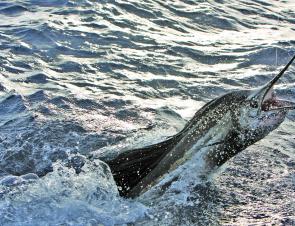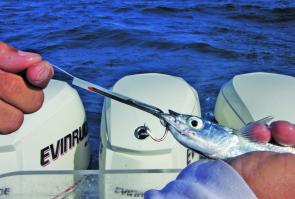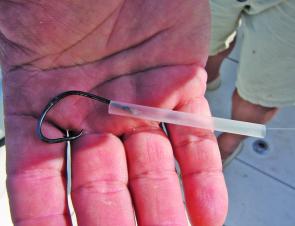I was recently shown a cheap, simple and nifty trick with a drinking straw to use when trolling for sailfish on live garfish bait, so I thought I’d give it a go.
Use a short piece of drinking straw to thread down the bait leader and over the garfish’s bill. To rig the live garfish, the circle hook is placed through and out of the lower jaw of the garfish and the hook’s shank is laid alongside the garfish’s bill. Once in this position the drinking straw tube is slid over the hook eye and shank.
The ideal length of drinking straw tube is around 5-7cm. Before heading out fishing you should check that the diameter of the drinking straw fits snugly over the hook eye. If it’s too loose, you’ll have a hard time getting the bait back into the water before he shakes free of the tubing.
This rig takes mere seconds to make and has to be one of the simplest live baiting tricks that I’ve ever seen. Even better, I towed baits rigged this way at speeds of around two knots (bumping the engines in and out of gear) for hours and the baits were just as healthy as when they first hit the water. I am not sure what the maximum length of time would be for the livies to remain healthy, because many of the baits never had much time in the water before they got eaten. We managed to raise 15 sailfish off the live gars over the first two days of trailing this new rigging method.
Garfish can be caught for bait by berleying up a school in the river, estuary or harbour. Small hooks rigged with pieces of prawn for bait are ideal terminal tackle. Alternatively, the prawns can be substituted with other baits including small pieces of bread or even floating bread flies. From experience garfish survive very well in a recirculating live well.
We procured enough drinking straws by recycling those that we received from a quick Slurpee and drink stop on the way to the boat ramp. Otherwise straws can be purchased at the supermarket in bulk. I’m not sure if there is a preferred colour or not, but we opted for clear straws.
Gone are the days where 80-120lb leader was used for bluewater surface trolling applications. Now, with more refined abrasive resistance being promoted by our line makers, line as light as 40lb Hi-Seas fluorocarbon can be used with consistent reliability. Similarly connecting snap swivels that were once the favourite tool to join our main leader to a shorter bait leader have been made redundant now that leader is run straight to the hook. But make sure you thread the drinking straw on before you tie on the hook.
With the straw rigged livie ready for trolling, all you have to do is find the sailfish. The first thing to look for is good structure that might hold bait. Then, using your sounder, go looking for schools of suspended bait and also surface bait.
Once you have found a few schools of suspended bait and marked them on your GPS then troll circles and figure eights around them, going from school to school. Over the years I’ve seen a lot more sails caught by working the bait schools than by trolling from structure to structure.
If a bait school shows on the sounder as starting to rise towards the surface then concentrate your efforts in that area for a while. It is likely that any school of baitfish that is rising towards the surface is being pushed from underneath by a big predatory fish or two.
In contrast if your efforts around the bait schools are not attracting strikes then focus on the stray fish that are wandering between the bait schools – these fish are often very keen to eat.
We trolled a spread of four live gars at a time, two from the outriggers and two from the corners as flat lines. We used a mixture of dropback clips on spin reels with the bail open and conventional overhead reels with the line running straight from the rod tip and the drag set lightly just above free spool. Both set-ups hooked fish for us and your choice should depend on what you are most comfortable with.
My advice is to keep it as simple as you can. By remaining focused, watching the baits and staying near the rods in the rod holders you can alleviate a lot of the need for fancy gizmos and gadgets. Ideally you should be able to see the trolled baits in the water, especially if your boat has a fly bridge or a tower.
Ideally you will see the sailfish before it eats your bait. Then you can whip the rod out of the rod holder and get ready to free spool the bait as soon as the sail opens its mouth behind your livie. This is particularly so if the sail is raised on one of the two corner flat lines.
If a bait gets eaten but you don’t get a hook-up, free spool another bait back into the same vicinity that the sailfish should be so that you can try to tease it up for another strike at another bait. Be sure to wind in the outfit that missed the strike so that it doesn’t get in the way.
Then let the sail eat the bait and wait until the fish has turned and is running away before you slide the lever up and then let the fish hook itself.
Lastly be persistent, the late afternoon bite, after everybody else has run back to the harbour, is often the best action for the whole day.
It is quite a thrill to see a sailfish behind your trolled live bait with the sail’s head and bill out of the water swishing each side of your garfish. It’s even more of a thrill when the same thing is happening behind two, three or even four of the livies. Everywhere you look the water is being carved up, rod tips bowing over into your peripheral vision, and everyone yelling euphorically hooked on great fish.
Reads: 9109
The author, Kim, and her dad, Steve, with a sailfish caught on the drinking straw live garfish rig.

With all the action and magnificent jumps everybody onboard enjoys the fight of the sail.

A school of garfish in the water; berleyed up and ready to be caught for bait.

A rigged live garfish, ready to be casted into the depths to raise a sail.

The drinking straw rig and circle hook.




